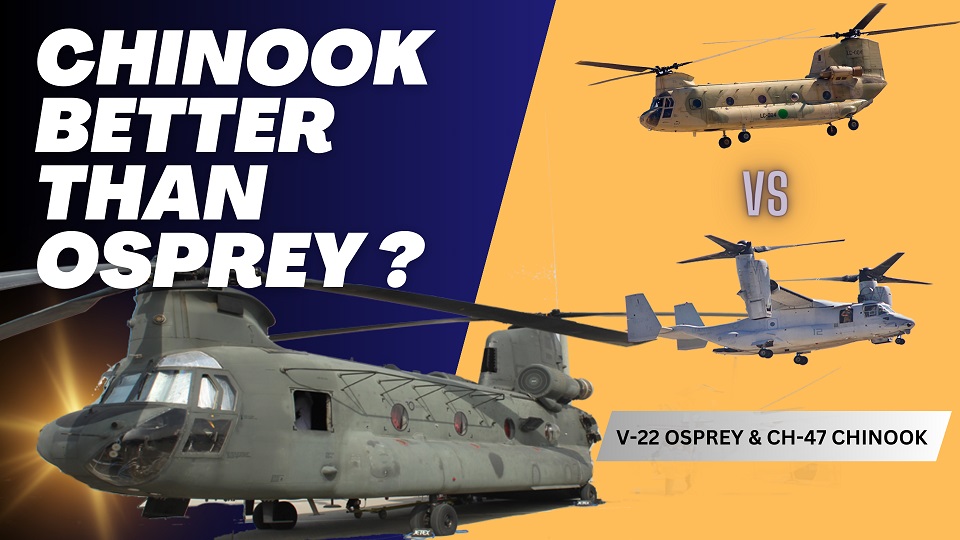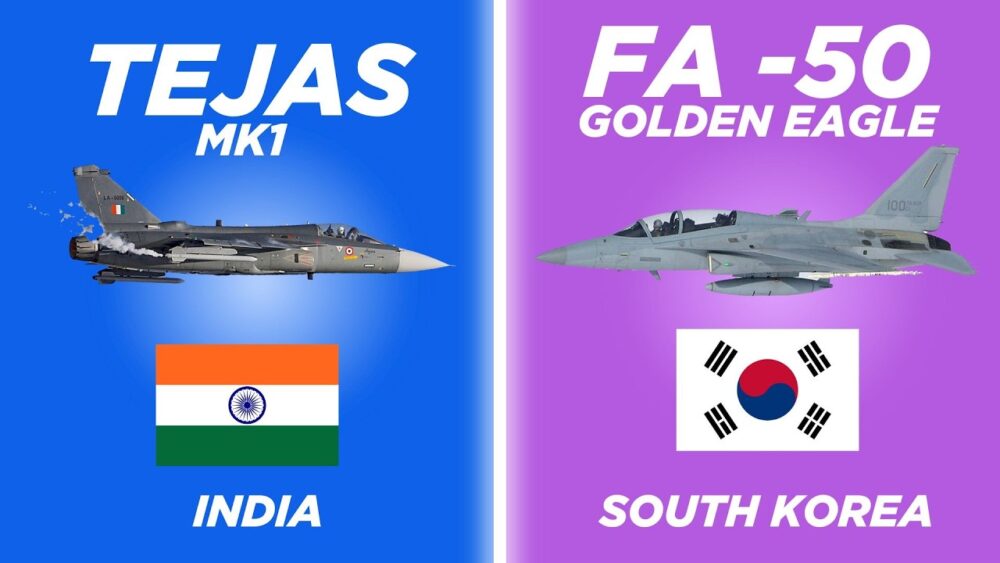Aircraft comparison
Osprey is faster than Chinook helicopter ?

In this article, we’ll delve into two distinct military aircraft that have played essential roles in United Air Force defense. Both aircraft have unique characteristics in terms of usage and flying capabilities. One is capable of vertical takeoff and flies like an aircraft, while the other is a helicopter with two tandem rotors. Let’s explore each of these aircraft in detail..
The speed of helicopters can vary depending on several factors such as their design, engine power, payload, and mission requirements. Generally speaking, the Osprey (specifically referring to the V-22 Osprey) is faster than the Chinook helicopter.
The V-22 Osprey is a tiltrotor aircraft, meaning it can take off and land vertically like a helicopter but also tilt its rotors forward to fly like an airplane. This design allows the Osprey to achieve higher speeds compared to conventional helicopters. The cruising speed of the V-22 Osprey is around 241 knots (277 mph or 446 km/h).
On the other hand, the Chinook helicopter, such as the Boeing CH-47 Chinook, has a cruising speed typically around 170 knots (196 mph or 315 km/h). While the Chinook is a highly capable and versatile helicopter known for its heavy-lift capabilities and reliability, it generally operates at lower speeds compared to the Osprey.
The comparison between an Osprey and a Chinook helicopter involves contrasting two distinct aircraft with different designs, capabilities, and purposes:
MV-22 Osprey details:
The Osprey has garnered significant controversy since its inaugural flight, primarily stemming from issues associated with its tiltrotor design. These challenges have led to several incidents and crashes, resulting in the tragic loss of pilots and crew members and prompting multiple groundings of the aircraft.
However, efforts are underway to address these technical issues swiftly, with plans to rectify the problems and resume flights promptly. Despite these setbacks, the Osprey remains crucial in operational contexts, offering enhanced capabilities for transporting both cargo and crew members, underscoring its pivotal role in various missions.
Except for the United States and Japan, no other country has been granted authorization to utilize the Osprey aircraft. Its unique design and specialized nature, being built in the United States, likely necessitate governmental permission for export to other nations.
The Osprey stands out for its groundbreaking design and innovation, featuring the ability to transition from vertical to horizontal rotor positions while also generating thrust like a conventional aircraft.
- MV-22 Osprey:
- The MV-22 Osprey is a tiltrotor aircraft, meaning it can take off and land like a helicopter but fly like a fixed-wing aircraft once airborne.
- It’s primarily used for vertical takeoff and landing (VTOL), troop transport, cargo transport, and aerial refueling.
- The Osprey has a unique ability to combine the vertical lift capability of a helicopter with the speed and range of a turboprop aircraft.
- It can carry up to 24 troops or 20,000 pounds of internal cargo and has a top speed of around 315 miles per hour (507 km/h).
- The Osprey is utilized by the U.S. Marine Corps, U.S. Air Force Special Operations Command, and other military forces around the world.
Boeing CH-47 Chinook:
The Chinook helicopter stands as a testament to unparalleled engineering and innovation, making it one of the most distinctive aircraft ever constructed. Since its inception, no other nation has attempted to replicate its singular design, owing to the extraordinary precision and aerospace technology required for its construction. This helicopter, revered as an engineering marvel, has become a staple in major battlegrounds, renowned for its exceptional capacity to transport troops and cargo to any destination. Remarkably versatile, it operates seamlessly on both land and water surfaces, boasting an integrated floating system that enhances its capabilities even further.
Selected countries have been granted permission to utilize the Chinook helicopter, showcasing its global appeal and strategic importance. Furthermore, ongoing development efforts are underway to enhance the speed and carrying capacity of the next version of this iconic aircraft. Renowned for its exceptional safety record, the Chinook stands as one of the safest helicopters in operation today, with a remarkably low incidence of crashes. Its versatility is unmatched, making it an invaluable asset for operations in diverse terrains and environments.
- Boeing CH-47 Chinook:
- The Chinook is a tandem rotor helicopter, known for its distinctive twin-rotor design.
- It’s a heavy-lift helicopter primarily used for troop transportation, artillery emplacement, battlefield resupply, and various other missions.
- The Chinook has a rear loading ramp for cargo and troops, making it well-suited for quick loading and unloading.
- It can carry up to 55 troops or 24,000 pounds of cargo internally and has a top speed of around 170 miles per hour (274 km/h).
- The Chinook is widely used by the U.S. Army and various other military forces worldwide, including the UK, Canada, and others.
Comparison:
- Design: The Osprey is a tiltrotor aircraft, while the Chinook is a tandem-rotor helicopter.
- Speed and Range: The Osprey has a higher top speed and longer range compared to the Chinook due to its fixed-wing aircraft capabilities.
- Payload Capacity: The Chinook generally has a higher payload capacity for both troops and cargo compared to the Osprey.
- Versatility: While both aircraft are versatile in their own right, Osprey’s ability to take off and land vertically as well as fly at high speeds over long distances gives it a unique advantage in certain scenarios. However, the Chinook’s ability to carry larger payloads makes it better suited for heavy lift operations.
- Cost and Maintenance: Maintenance and operating costs may vary between the two aircraft, with tiltrotor technology typically being more complex than traditional helicopter designs.

Aircraft comparison
Comparison of the Indian built Tejas MK1A vs South korean FA 50

Today, we’ll explore two remarkable light combat aircraft: the Tejas MK1A and the FA-50 Golden Eagle. Both fighters are designed for versatility, making them ideal for various missions, from air-to-air combat to ground support.
The Tejas MK1A, developed by Hindustan Aeronautics Limited (HAL) in India, and the FA-50, a product of Korea Aerospace Industries (KAI), are both advanced aircraft equipped with modern technology and features.
10 Fascinating Facts About India’s AMCA Fighter Jet
In this Article, we will compare these two fighters in terms of their specifications, performance, capabilities, and roles in modern air forces. Let’s dive in and see how they stack up against each other!
Tejas is the second supersonic combat aircraft developed by Hindustan Aeronautics Limited (HAL), following the HF-24 Marut. It took its first flight in 2001 and was inducted into service with the Indian Air Force (IAF) in 2015. Currently, Tejas holds the distinction of being the smallest and lightest aircraft in its class of supersonic combat jets.
On the other hand, the FA-50 is South Korea’s first indigenous supersonic aircraft and is one of the few supersonic trainers in the world. Development of the T-50 began in the late 1990s, with its maiden flight taking place in 2002.
Russia Seeks Talks with India, Offers Tu-160 Bombers at Unbeatable Prices
The FA-50 boasts a higher production rate compared to the Tejas. Over the past 15 years, Korea Aerospace Industries (KAI) has produced nearly 200 variants of the FA-50, while Tejas has seen a lower production output.
In terms of international sales, the FA-50 is actively in service with multiple countries, including Indonesia, Iraq, the Philippines, Thailand, and Poland. Notably, Malaysia opted for the FA-50 over the Tejas, citing the FA-50’s strong service record as a key factor in their decision.
Here’s a SPECIFICATION of the Tejas and FA-50
Length: The Tejas measures 13.2 m (43 ft 4 in), making it slightly longer than the FA-50, which is 13.14 m (43 ft 1 in).
Max Takeoff Weight: The Tejas has a maximum takeoff weight of 13,500 kg (29,762 lb), compared to the FA-50’s lighter weight of 10,722 kg (23,638 lb).
Fuel Capacity: The Tejas has an internal fuel capacity of 3,060 liters (810 US gallons), while the FA-50 has a slightly lower internal fuel capacity of 2,655 liters (701 US gallons).
Powerplant: Both aircraft are powered by General Electric F404 turbofan engines, but the Tejas utilizes the F404-GE-IN20 variant with 48.9 kN (11,000 lbf) thrust dry and 85 kN (19,000 lbf) with afterburner. The FA-50 features the F404-GE-102 variant, producing 53.07 kN (11,930 lbf) thrust dry and 78.7 kN (17,700 lbf) with afterburner.
Maximum Speed: The Tejas has a maximum speed of 2,220 km/h (Mach 1.8), which is significantly faster than the FA-50’s maximum speed of 1,837.5 km/h (Mach 1.5).
Combat Range: The Tejas has a combat range of 739 km (459 mi), whereas the FA-50 has a much longer range of 1,851 km (1,150 mi).
Hardpoints: The Tejas features 9 hardpoints with a total capacity of 5,300 kg, while the FA-50 has 7 hardpoints capable of carrying up to 5,400 kg of payload.
Cost: The Tejas is priced at approximately $40 million per unit, whereas the FA-50 ranges between $30 million to $40 million per unit, making the FA-50 potentially more cost-effective depending on the variant chosen.
Weapons
When it comes to weaponry, the Tejas MK1A offers a wider range of options compared to the FA-50 Golden Eagle. The Tejas MK1A is equipped with beyond-visual-range (BVR) missiles, allowing it to engage targets at greater distances, enhancing its combat effectiveness in air superiority missions. Additionally, it can carry precision-guided munitions for accurate strikes against ground targets, as well as standoff weapons, which can be launched from a distance to minimize exposure to enemy defenses. This diverse armament enables the Tejas to perform a variety of roles, from air-to-air combat to ground support.
In contrast, the FA-50 also features a respectable armament capability but has a more limited selection. It can carry air-to-air missiles like the AIM-9 Sidewinder and AIM-120 AMRAAM, as well as precision-guided bombs. However, its focus leans more toward close air support and light strike missions rather than the extensive versatility that the Tejas offers.
Naval Variant
The Tejas Mk1A has a naval variant designed for carrier operations, which is still in development. This version includes upgrades like a nose droop for better visibility during landings and takeoffs, a strengthened undercarriage, and an arrestor hook for safe landings on aircraft carriers.
In contrast, the FA-50 does not have a naval variant. While it’s versatile for different missions, it’s not designed for carrier operations, limiting its flexibility compared to the naval Tejas, which can operate from both land and carriers.
-

 Aviation2 months ago
Aviation2 months agoMicrosoft Flight Simulator Raises $3 Million to Bring Back the An-225 Mriya
-

 Airlines2 months ago
Airlines2 months agoQatar Citizens Can Travel to the United States Without a Visa
-

 Aviation2 months ago
Aviation2 months agoQatar Airways bans these new Electronic Devices on plane
-

 Airlines2 months ago
Airlines2 months agoJapan Airlines Rolls Out Free Domestic Flights to International Passengers
-

 Defence2 months ago
Defence2 months agoWhich Country Has the Largest Fleet of Fighter Aircraft?
-

 Airport2 months ago
Airport2 months agoWestern Sydney Airport Welcomes Its First Plane After 6 Years of construction
-

 Airlines4 days ago
Airlines4 days agoDAMAC Air: Dubai’s New Luxury Airline Offers Free Flights for Registration
-

 Aviation2 months ago
Aviation2 months agoDid you know ? Once Boeing 747 carried 1088 passenger in 1991








